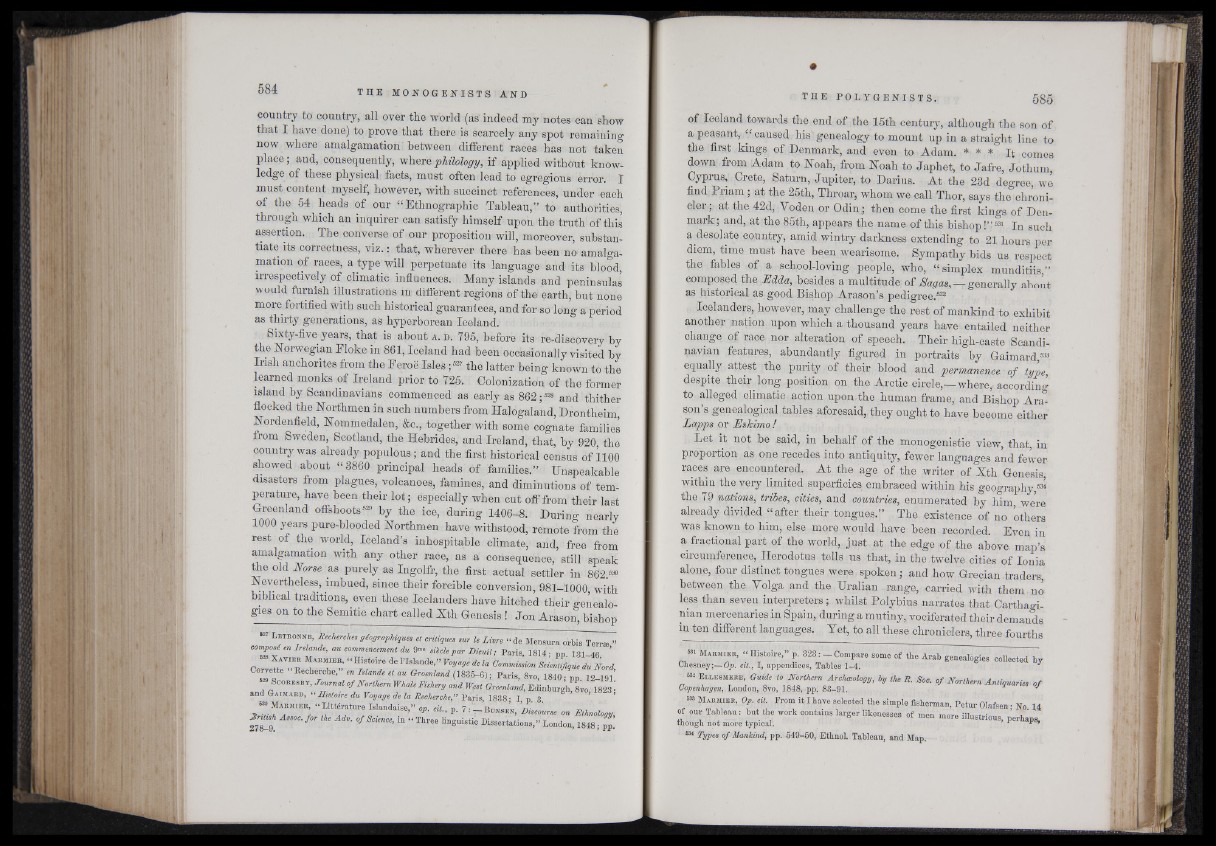
country to country, all over the world (as indeed my notes can show
that I have done) to prove that there is scarcely any spot remaining
now where amalgamation between different races has not taken
place; and, consequently, where philology, if applied without knowledge
of these physical facts, must often lead to egregious error. I
must content myself, however, with succinct references, under each
of the-54 heads of our “Ethnographic Tableau,” to authorities,
through which an inquirer can satisfy himself upon the truth of this
assertion. The converse of our proposition will, moreover, substantiate
its correctness, viz. : that, wherever there has been no amalga-
mation of races, a type will perpetuate its language and its blood,
irrespectively of climatic influences. Many islands and peninsulas
would furnish illustrations in different regions of the earth, hut none
more fortified with such historical guarantees, and for so long a period
as thirty generations, as hyperborean Iceland.
Sixty-five years, that is about a . d . 795, before its re-discovery by
the Norwegian Floke in 861, Iceland had been occasionally visited by
Irish anchorites from the Eeroë Isles ;527 the latter being known to the
learned monks of Ireland prior to 725. Colonization of the former
island by Scandinavians commenced as early as 862; 528 and thither
flocked the Northmen in such numbers from Halogaland, Drontheim
Nordenfield, Nommedalen, &c., together with some cognate families
from Sweden, Scotland, the Hebrides, and Ireland, that, by 920, the
country was already populous ; and the first historical census of 1100
showed about “ 3860 principal heads of families,” Unspeakable
disasters from plagues, volcanoes, famines, and diminutions of temperature,
have been their lot; especially when cut off from their last
Greenland offshoots629 by the ice, during 1406-8. During nearly
1000 years pure-blooded Northmen have withstood, remote from the
rest of the world, Iceland’s inhospitable climate, and, free from
amalgamation with any other race, as a corisequence, still speak
the old Norse as purely as Ingolfr, the first actual settler in 862.™
Nevertheless, imbued, since their forcible conversion, 981-1000 with
biblical traditions, even these Icelanders have hitched their genealo
gies on to the Semitic chart called Nth Genesis ! Jon Arason, bishop
Letronne, Recherches géographiques et critiques sur le Livre “ de Mensura o'rbis Terrai ”
composé en Irélande, au commencement du 9“ = siècle par Dicuil; Paris, 1814 • d d 131-4R ’
628 * AV™ 1 “ Histoire de Voyagé de la Ùommission Scientifique du Nord
Corvette Recherche, en Islande et au Groenland (1836-6); Paris, 8vo, 1840; pp 12-19l’
_Scoresby, Journal of NorthemWhale Fishery andWfsl Greenland, Edinburgh, 8vo-1823-
and G a im a r d , “ Histoire du Voyage de la Recherche," Paris, 1838.; X, p . 3 ’ ’
“ MaemieR; i S K Islanda^>” op. cit., p . 7 ( -B u n s e n , discourse on Ethnology
278-9. fortheAdv- °f Sctm°e> “ “ Three linguistic Dissertations,” London, 1848; pp.
of Iceland towards the end of the 15th century, although the son of
a peasant, “ caused his genealogy to mount up in a straight line to
the first kings of Denmark, and even to Adam. * *, * it comes
down from Adam to Noah, from Noah to Japhet, to Jafre, Jothum,
Cyprus, Crete, Saturn, Jupiter, to Darius. At the 23d degree we
find Priam; at the 25th, Throar, whom we call Thor, says the chronicler;,
at the 42d, Voden or Odin,; then come the first kings of Denmark;
and, at the 85th, appears the name of this bishop!” 631 In such
a desolate country, amid wintry darkness extending to 21 hours per
diem, time must have been wrearisome. Sympathy bids us respect
the fables of a school-loving people, who, “ simplex munditiis,”
composed the Edda, besides a multitude of Sagas, — generally about
as historical as good Bishop Arason’s pedigree.632
Icelanders, however, may challenge the rest of mankind to exhibit
another nation upon which a thousand years have entailed neither
change of race nor alteration of speech. Their high-easte Scandinavian
features, abundantly figured in portraits by Gaimard533
equally,attest the purity of their blood and permanence of type,
despite their long position on the Arctic circle,—where, according
to alleged climatic action upon,the human frame, and Bishop Arason’s
genealogical tables aforesaid,, they ought to have beeome either
Lapps or Eskimo !
;, Let it not be said, in behalf of the monogenistic view, that, in
proportion as one recedes into antiquity, fewer languages and fewer
races are encountered. At the age of the writer of Xth Genesis,
within the very limited superficies embraced within his geography,63*
the 79 nations, tribes, cities, and countries, enumerated by him, were
already divided “ after their tongues.” The existence of no others
was known to him, else more would have been recorded. Even in
a fractional part of the world, just at the edge of the above map’s
circumference, Herodotus tells us that, in the twelve cities of Ionia
alone, four distinct tongues were spoken; and how Grecian traders
between the Volga and the Uralian range, carried with them no
less than seven interpreters; whilst Polybius narrates, that-Carthaginian
mercenaries in Spain, during a mutiny, vociferated their demands
in ten different languages. Vet, to all these chroniclers, three fourths
»1 Ma rm iee , “ Histoire,” p. 323: A Compare some of the Arab genealogies collected by
Chesney;—Op. cit., I, appendices, Tables 1-4:
“ » E l lesm ere, Guide to Northern Arihwology, by the R. Soc. of Northern Antiouaries of
Copenhagen, London, 8vo, 1848, pp. 83^91.
“ » Ma rm iee , Op. cit. From it I have selected the simple fisherman, Petnr Olafsen • No 14
of our Tableau : but the work contains larger likenesses of men more illustrious n’erhana.
though not more typical. ’
684 Types of Mankind^ pp. 549-50, Ethnol. Tableau, and Map.